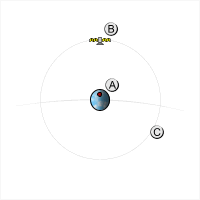Ground track
Ground track or ground trace is the path on the surface of the Earth (or any celestial body) directly below an aircraft, satellite, or other object in flight. It represents the projection of the object's trajectory onto the Earth's surface. The concept of a ground track is crucial in various fields such as aviation, satellite communication, and spaceflight, where understanding the path of a flying object relative to the ground is essential for navigation, communication, and observational purposes.
Overview[edit | edit source]
The ground track is influenced by several factors, including the object's speed, altitude, and the Earth's rotation. For aircraft, the ground track can be relatively straightforward, often mirroring the aircraft's intended flight path, allowing for adjustments due to wind and air traffic control requirements. In contrast, the ground track of a satellite is more complex due to the high speeds, the influence of gravitational forces, and the Earth's rotation. Satellites in low Earth orbit (LEO) can complete an orbit in approximately 90 minutes, resulting in a rapidly changing ground track that can cover most of the Earth's surface in a day.
Satellite Ground Tracks[edit | edit source]
For satellites, the ground track is a vital consideration in mission design and operation. The shape and coverage of a satellite's ground track depend on its orbit. For example, satellites in geostationary orbit (GEO) have a ground track that appears as a single point on the Earth's equator, as they orbit at the same rate as the Earth's rotation. In contrast, satellites in polar or near-polar orbits have ground tracks that pass close to both poles, with successive orbits shifting to the west or east due to the Earth's rotation, allowing these satellites to eventually cover the entire Earth's surface.
Importance of Ground Tracks[edit | edit source]
Ground tracks are essential for:
- Navigation: In aviation, pilots and air traffic controllers use ground tracks to plan and monitor flight paths.
- Communication: Satellite communication systems rely on knowing the ground track to align ground stations with satellites for effective data transmission.
- Observation: Earth observation satellites use their ground tracks to plan imaging sessions, ensuring coverage of specific areas of interest.
Calculating Ground Tracks[edit | edit source]
The calculation of a ground track involves understanding the object's motion relative to the Earth, including its speed, direction, and altitude, as well as the Earth's shape and rotation. For satellites, this calculation is more complex and requires the use of orbital mechanics and computer simulations to predict the satellite's path over the Earth.
Applications[edit | edit source]
Ground tracks have a wide range of applications, including:
- Planning satellite observation missions to ensure coverage of specific geographical areas.
- Designing satellite communication networks to provide continuous coverage to certain regions.
- Air traffic management, to ensure safe and efficient routing of aircraft.
Challenges[edit | edit source]
Challenges in managing and predicting ground tracks include:
- The need for precise calculations and adjustments for satellites, especially in crowded orbits.
- The impact of atmospheric conditions on aircraft ground tracks, requiring constant monitoring and adjustment.
- The dynamic nature of the Earth's atmosphere and gravitational field, which can affect satellite orbits and ground tracks over time.
This spaceflight related article is a stub. You can help WikiMD by expanding it.
Search WikiMD
Ad.Tired of being Overweight? Try W8MD's physician weight loss program.
Semaglutide (Ozempic / Wegovy and Tirzepatide (Mounjaro / Zepbound) available.
Advertise on WikiMD
|
WikiMD's Wellness Encyclopedia |
| Let Food Be Thy Medicine Medicine Thy Food - Hippocrates |
Translate this page: - East Asian
中文,
日本,
한국어,
South Asian
हिन्दी,
தமிழ்,
తెలుగు,
Urdu,
ಕನ್ನಡ,
Southeast Asian
Indonesian,
Vietnamese,
Thai,
မြန်မာဘာသာ,
বাংলা
European
español,
Deutsch,
français,
Greek,
português do Brasil,
polski,
română,
русский,
Nederlands,
norsk,
svenska,
suomi,
Italian
Middle Eastern & African
عربى,
Turkish,
Persian,
Hebrew,
Afrikaans,
isiZulu,
Kiswahili,
Other
Bulgarian,
Hungarian,
Czech,
Swedish,
മലയാളം,
मराठी,
ਪੰਜਾਬੀ,
ગુજરાતી,
Portuguese,
Ukrainian
Medical Disclaimer: WikiMD is not a substitute for professional medical advice. The information on WikiMD is provided as an information resource only, may be incorrect, outdated or misleading, and is not to be used or relied on for any diagnostic or treatment purposes. Please consult your health care provider before making any healthcare decisions or for guidance about a specific medical condition. WikiMD expressly disclaims responsibility, and shall have no liability, for any damages, loss, injury, or liability whatsoever suffered as a result of your reliance on the information contained in this site. By visiting this site you agree to the foregoing terms and conditions, which may from time to time be changed or supplemented by WikiMD. If you do not agree to the foregoing terms and conditions, you should not enter or use this site. See full disclaimer.
Credits:Most images are courtesy of Wikimedia commons, and templates Wikipedia, licensed under CC BY SA or similar.
Contributors: Prab R. Tumpati, MD




